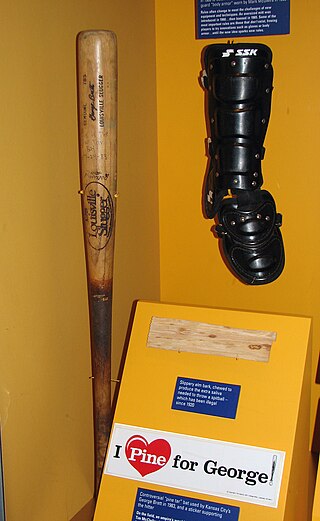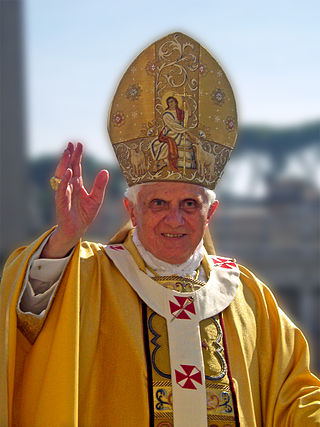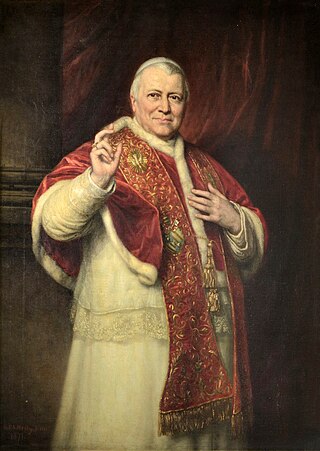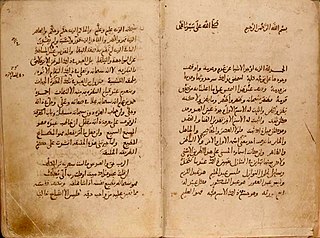
The pope, also known as the supreme pontiff, Roman pontiff or sovereign pontiff, is the bishop of Rome, head of the worldwide Catholic Church, and has also served as the head of state or sovereign of the Papal States and later the Vatican City State since the eighth century. From a Catholic viewpoint, the primacy of the bishop of Rome is largely derived from his role as the apostolic successor to Saint Peter, to whom primacy was conferred by Jesus, who gave Peter the Keys of Heaven and the powers of "binding and loosing", naming him as the "rock" upon which the Church would be built. The current pope is Francis, who was elected on 13 March 2013.

Pope John Paul II was head of the Catholic Church and sovereign of the Vatican City State from 1978 until his death in 2005. He was later canonised as Pope Saint John Paul II.
Pope Vigilius was the bishop of Rome from 29 March 537 to his death. He is considered the first pope of the Byzantine papacy. Born into Roman aristocracy, Vigilius served as a deacon and papal apocrisiarius in Constantinople. He allied with Empress Theodora, who sought his help to establish Monophysitism, and was made pope after the deposition of Silverius. After he refused to sign Emperor Justinian I's edict condemning the Three Chapters, Vigilius was arrested in 545 and taken to Constantinople. He died in Sicily while returning to Rome.

Autograph collecting is the practice of collecting autographs of famous persons. Some of the most popular categories of autograph subjects are presidents, military soldiers, athletes, movie stars, artists, social and religious leaders, scientists, astronauts, and authors.

Sports memorabilia refers to collectables associated with sports. Types include equipment, trophies, sports cards, autographs, photographs, etc.
A papal renunciation also called a papal abdication, occurs when the reigning pope of the Catholic Church voluntarily steps down from his position. As the reign of the pope has conventionally been from election until death, papal renunciation is an uncommon event. Before the 21st century, only five popes unambiguously resigned with historical certainty, all between the 10th and 15th centuries. Additionally, there are disputed claims of four popes having resigned, dating from the 3rd to the 11th centuries; a fifth disputed case may have involved an antipope.
The composer Wolfgang Amadeus Mozart went by many different names in his lifetime. This resulted partly from the church traditions of the day, and partly from Mozart being multilingual and freely adapting his name to other languages.
An autograph is a person's signature, but may also refer to:

The tau cross is a T-shaped cross, sometimes with all three ends of the cross expanded. It is called a “tau cross” because it is shaped like the Greek letter tau, which in its upper-case form has the same appearance as Latin letter T.

The Personal Apostolic Administration of Saint John Mary Vianney was established on 18 January 2002 by Pope John Paul II for traditionalist Catholic clergy and laity within the Diocese of Campos in Brazil. It is the only personal apostolic administration in existence, and the only canonically regular Catholic Church jurisdiction devoted exclusively to celebrating the pre-1965 form of the Roman Rite. Its current Apostolic Administrator is Bishop Fernando Arêas Rifan.

Deus caritas est, subtitled De Christiano Amore, is a 2005 encyclical, the first written by Pope Benedict XVI, in large part derived from writings by his late predecessor, Pope John Paul II. Its subject is love, as seen from a Christian perspective, and God's place within all love. Charity is one of the three theological virtues; and the other two were treated in two successive encyclicals, one signed by Benedict and one written substantially by him but signed by his successor Pope Francis . This text begins with a reflection on the forms of love known in Greek philosophy—eros, agape, philia (friendship)—and their relationship with the teachings of Jesus.

The four orchestral suites BWV 1066–1069, are four suites by Johann Sebastian Bach from the years 1724-1731. The name ouverture refers only in part to the opening movement in the style of the French overture, in which a majestic opening section in relatively slow dotted-note rhythm in duple meter is followed by a fast fugal section, then rounded off with a short recapitulation of the opening music. More broadly, the term was used in Baroque Germany for a suite of dance-pieces in French Baroque style preceded by such an ouverture. This genre was extremely popular in Germany during Bach's day, and he showed far less interest in it than was usual: Robin Stowell writes that "Telemann's 135 surviving examples [represent] only a fraction of those he is known to have written"; Christoph Graupner left 85; and Johann Friedrich Fasch left almost 100. Bach did write several other ouverture (suites) for solo instruments, notably the Cello Suite no. 5, BWV 1011, which also exists in the autograph Lute Suite in G minor, BWV 995, the Keyboard Partita no. 4 in D, BWV 828, and the Overture in the French style, BWV 831 for keyboard. The two keyboard works are among the few Bach published, and he prepared the lute suite for a "Monsieur Schouster," presumably for a fee, so all three may attest to the form's popularity.
Ecclesiastical letters are publications or announcements of the organs of Roman Catholic ecclesiastical authority, e.g. the synods, but more particularly of pope and bishops, addressed to the faithful in the form of letters.

The rota is one of the symbols used by the pope to authenticate documents such as papal bulls. It is a cross inscribed in two concentric circles. Pope Leo IX was the first pope to use it.
Orientales ecclesias is an encyclical of Pope Pius XII concerning the persecution of the Eastern Catholic Churches and describing the desperate situation of the faithful in Bulgaria.

Papal infallibility is a dogma of the Catholic Church which states that, in virtue of the promise of Jesus to Peter, the Pope when he speaks ex cathedra is preserved from the possibility of error on doctrine "initially given to the apostolic Church and handed down in Scripture and tradition". It does not mean that the pope cannot sin or otherwise err in most situations.

William Shakespeare's handwriting is known from six surviving signatures, all of which appear on legal documents. It is believed by many scholars that the three pages of the handwritten manuscript of the play Sir Thomas More are also in William Shakespeare's handwriting. This is based on many studies by a number of scholars that considered handwriting, spelling, vocabulary, literary aspects, and more.

Letter to Women is a pastoral letter written by Pope John Paul II to all women, and deals with the rights and dignity of women, the many challenges that women in the modern era have had to face, and ways in which the cause of woman could be forwarded in the world. Written June 29, 1995, the letter drafted in anticipation of the Fourth World Conference on Women in September 1995, hosted by the United Nations in Beijing. This letter was an affirmation to the continuing thought of Pope John Paul II on the importance of women in the Church, and the special roles in which only they can contribute in the realms of the family, the Church, and the world. In his pontificate which lasted longer than 26 years, he continuously upheld the dignity and honor of women, and this letter was a significant contribution to his corpus of works on the importance of women within the Church.
Il rapido sviluppo is an apostolic letter signed by Pope John Paul II on 24 January 2005; it mainly addresses those who are involved in communications.

An autograph or holograph is a manuscript or document written in its author's or composer's hand. The meaning of autograph as a document penned entirely by the author of its content, as opposed to a typeset document or one written by a copyist or scribe other than the author, overlaps with that of holograph.












